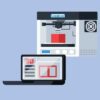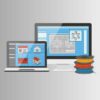3D Printing Software Market Summary:
The 3D printing software market has been experiencing significant growth in recent years, thanks to the increasing adoption of 3D printing technology across various industries. This software plays a crucial role in the entire 3D printing process, from designing to printing the final product. It enables users to create, modify, and optimize 3D models, ensuring precision and accuracy. One of the key drivers of the 3D printing software market is the growing demand for customized products. With 3D printing software, manufacturers can easily tailor their products to meet specific customer requirements, resulting in higher customer satisfaction. This has led to the widespread use of 3D printing technology in industries such as automotive, aerospace, healthcare, and consumer goods. Moreover, the advancements in 3D printing software have made it more user-friendly and accessible to a wider audience. Even individuals with limited technical knowledge can now design and print their own 3D models. This has opened up new opportunities for small businesses and entrepreneurs to bring their ideas to life without the need for expensive manufacturing equipment.
In addition, the integration of artificial intelligence (AI) and machine learning (ML) technologies in 3D printing software has further enhanced its capabilities. These technologies enable the software to analyze and optimize designs, improve printing efficiency, and reduce material waste. As a result, manufacturers can achieve higher productivity and cost savings. The 3D printing software market is highly competitive, with several key players offering a wide range of software solutions. These solutions vary in terms of features, compatibility, and pricing, catering to the diverse needs of different industries and users. It is essential for businesses to choose the right software that aligns with their specific requirements and budget. The 3D printing software market is witnessing rapid growth due to the increasing demand for customized products and advancements in technology. This software empowers manufacturers and individuals to unleash their creativity and bring innovative ideas to life. As the market continues to evolve, we can expect further advancements in 3D printing software, making it even more accessible and efficient for users worldwide.
3D Printing Software Market Overview:
The 3D Printing Software Market overview provides a comprehensive understanding of the analyzed market. It includes an introduction to the market, its size, growth rate, and key trends. This aims to give clients a broad understanding of the market landscape. The market analysis of the 3D Printing Software Market delves deeper into the market dynamics, focusing on factors such as market drivers, challenges, and opportunities. It explores the macroeconomic and microeconomic factors affecting the market, industry regulations, and emerging market trends. The analysis provides valuable insights into the current and future market conditions.
The assessment of the 3D Printing Software Market is performed by taking various factors into consideration, like, for instance, the business expansion policies of key players, competitive analysis of the progress of new entrants and emerging players, and the revenue, financial, and opportunity analysis of market players. The also analyzed based on regional segmentation, type or technique, end-user spectrum, etc. This research implements the latest methodologies to help clients understand the overall market scenario and strategize accordingly. The 3D Printing Software Market report provides an overview of the different types of analysis conducted during the market research process, including but not limited to SWOT analysis, Porter's Five Forces analysis, PESTLE analysis, and market forecasting. These analyses provide a deeper understanding of the market dynamics and assist in making informed business decisions.
Major players included in the 3D Printing Software Market:
- Trimble, Inc.
- Foundry Visionmongers Limited
- FreeCAD
- Autodesks, Inc.
- Ultimaker BV PTC
- Relativity Space, Inc.
- nTopology, Inc.
- Proto Labs, Ltd.
- Desktop Metal
- Xometry
- Gowforge, Inc.
3D Printing Software Market Segmentation:
By Offerings
- Printers
- Desktop
- Industrial
- Material
- Type
- Plastic
- Thermoplastics
- PLA
- ABS
- Nylon
- Others
- Photopolymers
- Thermoplastics
- Metal
- Titanium
- Nickel
- Steel
- Aluminum
- Plastic
- Ceramics
- Other Material
- Type
- Services
- Software
- Designing Software
- Data Preparation Software
- Simulation Software
- Machine Control Software
By Technology
- Digital Light Processing (DLP)
- Electron Beam Melting (EBM)
- Selective Laser Sintering (SLS)
- Direct Metal Laser Sintering (DMLS)
- Polyjet / Multijet Printing (MJP)
- Fused Deposition Modeling (FDM)
- Stereolithography (SLA)
By Process
- VAT Photopolymerization
- Material Extrusion
- Binder Jetting
- Material Jetting
- Powder Bed Fusion
- Other Process
By Application
- Tooling
- Prototyping
- Functional Part Manufacturing
By End Use
- Consumer Products
- Energy
- Education
- Railway
- Jewelry
- Food & Culinary
- Automotive
- Industrial
- Aerospace & Defense
- Healthcare
- Architecture & Construction
- Others
Future Market Analytics Focus Points:
- SWOT Analysis
- Key Market Trends
- Key Data -Points Affecting Market Growth
- Revenue and Forecast Analysis
- Growth Opportunities For New Entrants and Emerging Players
- Key Player and Market Growth Matrix
3D Printing Software Market Competitive Analysis:
The competitive analysis of the 3D Printing Software Market assesses the competitive landscape of the market. It includes evaluating key players in the industry, their market share, business strategies, and competitive advantages. The competitive analysis also highlights the strengths and weaknesses of major competitors, allowing clients to understand the competitive positioning of companies operating in the market.
Objectives of the Study:
- To provide a comprehensive analysis on the 3D Printing Software Market by segmentation and by region
- To cater extensive insights on factors influencing the market growth (drivers, restraints, industry-specific restraints, business expansion opportunities)
- To anticipate and analyse the market size expansion in key regions- North America, Europe, Asia Pacific, Latin America and Middle East and Africa
- To record and evaluate competitive landscape mapping- strategic alliances and mergers, technological advancements and product launches, revenue and financial analysis of key market players
How our market research reports help clients:
Our market research reports provide valuable insights to clients in their decision-making process and support their growth and market capture efforts. They offer:
- Comprehensive understanding of market trends, dynamics, and growth potential.
- Identification of niche markets and emerging opportunities.
- Assessment of competitive landscape and strategic benchmarking.
- Insights into consumer preferences, buying behavior, and market demand.
- Risk assessment and mitigation strategies.
- Market forecasting and trend analysis for informed business planning.
- Understanding product development, pricing, and other strategies.
In case of any specific requirements or changes to the current table of content based on your scope, please contact us at: enquiry@futuremarketanalytics.com






















